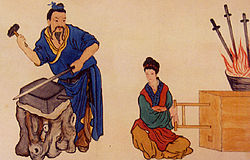Your Cart is Empty


While Japan proved instrumental in pioneering the art of differential heat treatment as well as the use of high-carbon steel, many of its techniques were influenced, at least to some degree, by its neighbor in China. Today, we're going to take a closer look at the history of Chinese swords, revealing what makes them unique and how they've changed over the years.
Jian vs Dao Chinese Swords
Before we begin, it's important to note that Chinese swords can be classified as either jian or dao. Jian swords featured two edges, whereas the dao swords featured a single edge. This classification has been used for centuries, and even today it remains a primary way in which Chinese swords are categorized.
Early Chinese Swords
Some of the first Chinese swords appeared during the country's Warring States period (501 to 350 BC). During this era, swordsmiths made rudimentary blades using cast bronze. Originally, these bronze swords weren't folded or laminated, resulting in weak and brittle construction. Later, however, Chinese swordsmiths began to laminate their blades with additional layers, allowing for increased strength and durability.
Qin Dynasty
The Qin dynasty (221 to 206 BC) was a turning point for Chinese swordmaking. While Chinese swordsmiths continued to make swords using cast bronze, they became longer and were designed for use with two hands. Furthermore, Chinese swordsmiths during the Qin dynasty used chromium oxide to protect their blades from rusting. This is significant because it wasn't until the 1930s and 1940s when the use of chromium oxide as an anti-corrosion coating was discovered by German and American scientists. Therefore, historians believe the process was lost after the Qin dynasty.
Han Dynasty
By the Han dynasty (1 to 220 AD), Chinese swordsmiths had perfected the folding and forging technique. This allowed for different grades of sword, depending on their respective quality. Chinese swordsmiths during this time would give swords a grade like 30, 50 or 100 refinings. The higher the refining rating, the better the sword's quality. Not surprisingly, higher rated swords sold for more than their lower rated counterpart.
Chinese Swords Today
Chinese swords remain a popular choice among collectors and martial arts practitioners today. They've been perfected over the years to become stronger and more functional, with some of the most common types being the butterfly swords, changao, miadao, hook sword, nandao, nuiweidao, piandao,